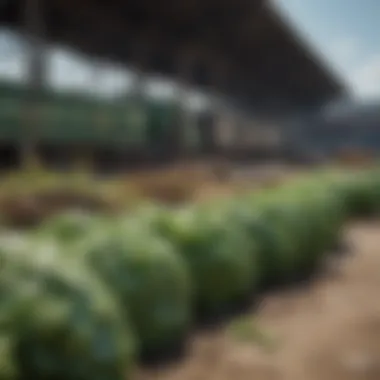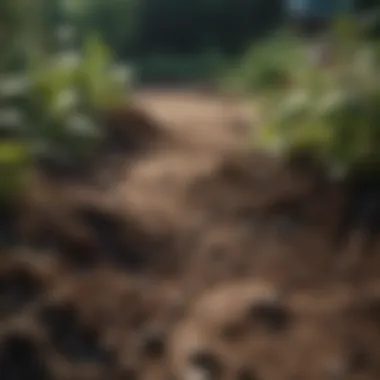Effective Yard Waste Disposal: A Practical Guide


Overview of the Topic
Yard waste is a major component of organic materials that contribute to garden aesthetics and ecosystem health. This includes grass clippings, leaves, branches, and other plant debris. Proper disposal of such waste is essential. When composted or recycled correctly, yard waste can enrich the soil, promote biodiversity, and prevent pollution. Conversely, improper disposal can lead to pollution and create additional waste management issues.
The significance of sustainable yard waste management cannot be overstated. With increasing urbanization and population density, the volume of yard waste generated is on the rise. By adopting responsible disposal methods, individuals and communities can play a critical role in supporting environmental health.
Current Status and Challenges
Currently, many communities face challenges related to the management of yard waste. A large portion of this waste ends up in landfills. Landfilling yard waste contributes to methane emissions, a potent greenhouse gas. Many municipalities lack effective yard waste collection programs or adequate facilities for recycling organic materials.
Some common challenges include:
- Limited Public Awareness: Many individuals are unaware of proper disposal methods or the environmental benefits of recycling yard waste.
- Insufficient Infrastructure: In some areas, the absence of composting facilities or drop-off sites complicates responsible disposal.
- Regulatory Restrictions: Specific regulations regarding organic waste disposal vary, leading to confusion among residents.
Sustainable Solutions
There are several sustainable practices that can mitigate the challenges of yard waste disposal. One effective solution is composting, where organic materials are broken down biologically. This can be done at home or through community composting programs.
Some tips for successful composting include:
- Layering Materials: Combine 'greens' (nitrogen-rich materials) with 'browns' (carbon-rich materials) in a 1:3 ratio.
- Maintenance: Turn the pile regularly to aerate it, promoting faster decomposition.
- Moisture Control: Keep the compost moist but not overly wet. Too much moisture can lead to unpleasant odors.
In addition to composting, the practice of chipping branches and using them as mulch enriches the soil while reducing waste. Successful community programs often serve as case studies for effective management. For example, places like Seattle have implemented comprehensive yard waste recycling programs that significantly reduce landfill contributions.
Impact and Importance
The impact of proper yard waste disposal extends beyond individual gardens. Healthy ecosystems benefit from the return of organic matter to the soil, supporting plant growth and overall health. Communities that engage in sustainable practices bolster local biodiversity and promote a greener environment.
Moreover, responsible management encourages others to follow suit, creating a ripple effect. The importance of these efforts lies not only in personal gardens but in their cumulative effect on communities and future generations. A commitment to sustainable resource management is vital for preserving the environment.
"The act of managing yard waste responsibly represents a commitment to both community health and ecological sustainability."
Prologue to Yard Waste Disposal
Disposing of yard waste properly is not just a chore; it is a responsible action that has lasting impacts on our environment. Yard waste, which includes grass clippings, leaves, twigs, and branches, constitutes a significant portion of residential waste. Understanding the best practices for its disposal is essential for maintaining outdoor spaces and promoting sustainability.
Understanding Yard Waste
Yard waste can be considered any organic material that arises from landscaping and gardening activities. It is not only composed of easily recognizable items like grass clippings or fallen leaves, but also includes less obvious debris such as small branches and inert plant matter. Knowing the exact composition of yard waste helps in deciding the appropriate disposal methods.
It’s important to comprehend that yard waste is biodegradable. When disposed of correctly, it can break down naturally, enriching the soil and reducing the amount of waste sent to landfills. Mismanagement of yard waste, on the other hand, can result in increased greenhouse gas emissions, as decomposing organic materials release harmful gases into the atmosphere.
Importance of Proper Disposal
Proper disposal of yard waste carries numerous benefits that extend beyond mere aesthetics. Firstly, it prevents unwanted pests and diseases from proliferating in the garden. Left untreated, rotting waste can attract insects and rodent populations.
Secondly, it conserves resources. Many communities have developed systems for collecting and recycling yard waste, which saves space in landfills and reduces disposal costs. Utilizing these systems contributes to a circular economy where waste is transformed into valuable materials, such as compost or mulch.
Moreover, by being diligent in yard waste management, individuals play a vital role in promoting environmental sustainability. The practice not only benefits personal gardening efforts but also contributes to more extensive community initiatives aimed at waste reduction and ecological preservation.
"Understanding and addressing the methods of yard waste disposal is crucial for sustanabilty and a healthy ecosystem."
In summary, effective yard waste management has both immediate and long-term benefits for the environment. As this article progresses, it will delve deeper into specific types of yard waste, the multitude of disposal methods available, and the implications of those methods for our ultimate environmental footprint.
Types of Yard Waste


Understanding the types of yard waste is fundamental for effective disposal. Each category has its own characteristics, which can influence how it is processed. By identifying and categorizing yard waste, homeowners and gardeners can implement better management strategies. This leads to more sustainable practices and minimizes the environmental impact. Proper classification ensures that yard waste is disposed of in a manner that is environmentally friendly and space efficient.
Grass Clippings
Grass clippings are a common form of yard waste. They accumulate quickly, especially during the growing season. Leaving these clippings on your lawn can actually benefit it by returning nutrients to the soil. This process is known as grass cycling. However, if you choose to dispose of grass clippings, consider composting or mulching them. Both options provide valuable organic material that can enhance soil health.
Here are a few things to note:
- Avoid piling grass clippings too high, as this can lead to anaerobic decomposition, resulting in unpleasant odors.
- If you use chemical fertilizers or pesticides, ensure these residues do not mix with clippings meant for composting.
- Many municipalities offer collection services for grass clippings, providing a convenient disposal method.
Branches and Twigs
Branches and twigs can result from regular yard maintenance or storm damage. This type of yard waste may require more effort to dispose of due to its size and rigidity. Chipping branches into smaller pieces is a popular method that allows for easier handling and can create mulch or chips for landscaping. Large branches may need to be cut into manageable sizes.
When disposing of branches and twigs:
- Check if local services provide curbside collection for larger branches.
- Some areas allow residents to drop off branches at recycling locations.
- Burning may be an option, but it is crucial to check local regulations to avoid fines or hazards.
"Properly managing branches and twigs helps maintain a tidy landscape and supports local ecology by returning nutrients to the soil."
Leaves
Leaves are another significant type of yard waste. They are generated in abundance during autumn but can also accumulate throughout the growing season. Composting leaves creates rich organic material for gardens. When leaves decompose, they improve soil structure and fertility.
However, disposal options vary:
- Raking leaves into piles is a traditional method, but be mindful of local ordinances regarding leaf disposal. Some communities facilitate curbside collection, while others may encourage composting.
- Mulching leaves can also be beneficial, as this reduces yard waste and enhances soil health.
- Ensure that leaves do not become wet and compacted, as this can lead to improper aerobic decomposition, resulting in odors.
In summary, recognizing the various types of yard waste aids in responsible management. Each type—grass clippings, branches and twigs, and leaves—presents unique challenges and opportunities in the disposal process. Identifying these can lead to effective strategies that enhance environmental sustainability and promote healthy gardens.
Methods for Disposing of Yard Waste
Disposing of yard waste efficiently plays a critical role in maintaining not only the aesthetic appeal of outdoor spaces but also in promoting environmental sustainability. As homeowners and yard enthusiasts seek to manage organic waste properly, understanding various methods for disposal is essential. Each method has distinct benefits, considerations, and procedures that address the unique types of yard waste, helping to minimize its impact on landfills and promoting recycling and reuse. Here is an overview of effective methods available for yard waste disposal.
Composting
Benefits of Composting
Composting provides a valuable opportunity to recycle yard waste into nutrient-rich materials for gardens. This method encourages a natural breakdown of organic materials, allowing for the transformation of yard waste into compost. Importantly, composting reduces the amount of waste sent to landfills, which subsequently minimizes methane emissions—a potent greenhouse gas. The unique characteristics of composting include its efficiency and its ability to enrich soil health, making it a popular choice for sustainable gardening.
How to Start a Compost Pile
Starting a compost pile involves layering green materials, like grass clippings, with brown materials, such as dried leaves or twigs. It is essential to maintain a proper ratio of these materials to promote decomposition. This method makes it simple and economical, allowing even novice gardeners to participate in sustainable practices. The unique feature of beginning a compost pile is its accessibility, requiring minimal investment while yielding significant rewards over time.
Maintaining a Compost Pile
Maintaining a compost pile requires periodic turning to aerate the materials and promote decomposition. Temperature monitoring can also be vital; the pile should reach certain levels of warmth to facilitate the breakdown process effectively. Regular moisture checks keep the compost from drying out or becoming too soggy. This maintenance is a straightforward practice that protects the investment and ensures a nutrient-dense compost is produced.
Mulching
What is Mulching?
Mulching involves covering soil with organic materials, usually derived from yard waste, to improve soil health and reduce weed growth. This practice effectively retains moisture, moderates temperature extremes, and adds organic matter to the soil as it decomposes. By using mulching, homeowners can utilize their yard waste efficiently while simultaneously enhancing garden productivity.
How to Create Mulch from Yard Waste


Creating mulch from yard waste is a simple process that involves shredding grass clippings, leaves, and small branches. Using a mulch mower or a chipper can expedite this. The unique aspect of this method is its DIY nature, allowing for customization based on the specific needs of the garden. This self-sufficient approach stands as a cost-effective option that reduces waste while enhancing soil quality.
Municipal Yard Waste Collection
How Collection Services Work
Municipal yard waste collection programs typically schedule regular pickups, allowing residents to place their yard waste curbside. The collected waste is then transported to facilities where it can be processed into compost or mulch. This method alleviates the burden on individuals, creating a communal approach to yard waste management. Its advantage lies in convenience, as homeowners can rely on service schedules without additional effort.
Preparing Waste for Pickup
Preparing yard waste for municipal pickup involves placing materials in designated bins or bags according to local guidelines. It is important to separate yard waste from regular trash to ensure proper processing. Following local regulations is key, as improper preparation can lead to rejected materials, resulting in wasted effort.
Taking Yard Waste to a Drop-off Site
Identifying Local Drop-off Locations
Many areas provide designated drop-off sites for yard waste, allowing residents to dispose of their waste responsibly. Searching local municipal websites can assist in identifying these locations. The convenience of drop-off sites offers a flexible alternative to collection services for those with larger amounts of waste or unique disposal needs.
What to Expect at a Drop-off Site
At a drop-off site, you can expect to find clearly marked areas for different types of yard waste. Staff may be present to assist and ensure proper disposal. Following site instructions for placement can enhance efficiency, and being aware of peak times may help avoid long waits. This method provides an effective means for environmental stewardship while encouraging community involvement.
Incineration and Burning
Understanding Local Regulations
Incineration and burning of yard waste are subject to local laws and regulations that vary significantly by location. Understanding these regulations is crucial to ensure compliance and avoid potential fines. In regions where burning is allowed, these guidelines often mandate the size of the burn pile, acceptable materials, and timing to mitigate air quality issues and fire hazards.
Safety Precautions
When engaging in incineration or burning, it is essential to follow safety precautions to prevent uncontrolled fires. This includes having a water source nearby, monitoring wind conditions, and ensuring that there are no flammable materials nearby. Additionally, wearing protective gear, such as gloves and masks, can prevent personal injury. This method, while effective in waste reduction, must be approached with caution to ensure both personal safety and environmental responsibility.
Environmental Impact of Yard Waste Disposal
Understanding the environmental impact of yard waste disposal is essential. Proper management of yard waste does not just relate to tidiness; it has far-reaching effects on ecosystems. Waste materials from gardens, lawns, and other outdoor spaces can release greenhouse gases when improperly disposed, primarily in landfills. By examining the implications of different disposal methods, we can identify strategies that align with sustainable practices.
Effects of Landfill Disposal
Disposing of yard waste in landfills contributes to several negative environmental outcomes. First, when organic material decomposes in anaerobic conditions, it produces methane, a potent greenhouse gas that is much more effective at trapping heat in the atmosphere than carbon dioxide. Composting, on the other hand, happens under more aerobic conditions that minimize methane emissions. Additionally, landfills occupy valuable land and generate leachate, which can contaminate soil and water sources. This toxic liquid can carry harmful chemicals and pollutants, posing a risk to wildlife and human health. In summary, burying yard waste has serious repercussions for both the environment and society.
Benefits of Composting for the Environment
Composting stands out as a compelling alternative to landfill disposal. It reduces the volume of waste sent to landfills and enriches soil, promoting healthy plant growth. Here are some key benefits of composting:
- Reduces Waste Volume: Composting cuts down the amount of organic waste reaching landfills, significantly lessening the burden on these facilities.
- Improves Soil Health: Adding compost to gardens enhances soil structure, nutrient content, and moisture retention. Healthy soil is critical for sustainable gardening and agriculture.
- Encourages Biodiversity: Composting supports a diverse array of microbial life in the soil, fostering healthier ecosystems.
- Mitigates Greenhouse Gas Emissions: By opting for composting, home gardeners can significantly lower methane emissions associated with traditional waste disposal methods.
"By viewing yard waste not just as refuse, but as a resource, communities can enhance local ecosystems and increase sustainability."
Adopting composting practices is a responsible step towards minimizing environmental impact, making it a favored choice among conservationists and eco-conscious individuals. Embracing these methods can lead to healthier communities and environments.
Best Practices for Yard Waste Disposal
Effective yard waste disposal practices are essential for promoting environmental health and sustainability. By adhering to proper disposal methods, individuals can minimize negative impacts on surrounding ecosystems. Operating outside of these best practices can lead to contamination, inefficient waste management, and increased landfill contributions. This section will delve into critical considerations and techniques necessary for responsible yard waste disposal, contributing positively to our communities and the environment.
Avoiding Contamination


Contamination is a major concern when disposing of yard waste. This occurs when non-organic materials, like plastic or metal, find their way into compost or mulching systems. Such contamination can hinder the composting process and even render the end product unsuitable for gardening or landscaping. To mitigate this risk, it is important to establish clear separation between organic and inorganic waste right from the start.
- Separation: Always sort yard waste as you collect it, ensuring that grass clippings, leaves, and branches are kept separate from trash and recyclables.
- Education: Inform everyone involved in yard maintenance about what constitutes appropriate yard waste and how to handle it correctly.
- Clear Labeling: If using bins for collection, label them clearly to prevent incorrect disposal.
Moreover, it's crucial to know which materials can be composted or mulched. For instance, diseased plants can pose a contamination risk if added to compost. It is safer to dispose of such materials through municipal waste services. Being aware of the items that can and cannot be included helps in maintaining a healthy disposal method.
"Effective waste segmentation reduces the volume of trash that enters landfills while enhancing the recycling potential of organic materials."
Seasonal Considerations
Seasonal shifts significantly influence yard waste generation. Different times of the year present various disposal challenges and opportunities. During spring and fall, for instance, yard waste tends to increase due to landscaping activities and natural cycles.
- Spring Cleaning: After winter, remove accumulated debris and dead branches to kick-start the growing season. Grass clippings and trimmings from bushes often pile up as gardening begins.
- Fall Cleanup: Autumn brings leaf drop, requiring increased disposal. Raking leaves regularly helps prevent over-accumulation, reducing the risk of contamination in compost bins.
Adapting disposal methods according to the season can enhance efficiency. For example, creating a larger compost pile in spring can help recycle fresh material quickly, while maintaining smaller, longer-lasting piles during dry seasons is prudent for managing moisture content.
In summary, understanding seasonal patterns helps in managing yard waste effectively. By planning around these natural rhythms, residents can lessen their impact on local waste systems while fostering environmentally-friendly practices.
Innovative Approaches to Yard Waste Management
Innovative approaches to yard waste management are essential in cultivating environmental stewardship and community resilience. As urban areas expand and populations increase, the task of managing yard waste takes on greater complexity. This section illuminates the importance of modern strategies that can address these challenges effectively. By adopting innovative methods, communities can substantially reduce the volume of waste sent to landfills while promoting sustainable practices that benefit ecosystems and public health.
Community Initiatives
Community initiatives play an integral role in fostering engagement and offering sustainable solutions for yard waste management. These programs often capitalize on local resources and leverage community participation to achieve common goals. One example is community composting programs, which allow residents to collectively manage organic material. Participants can exercise a hands-on role in transforming yard waste into valuable compost, subsequently reducing landfill contributions.
"Community-driven waste management fosters not only environmentally responsible practices but also strengthens social bonds among residents."
Local governments can also facilitate clean-up events where residents gather to properly dispose of yard waste. These initiatives often educate participants not only on the importance of proper disposal but also on the advantages of reusing materials. Furthermore, neighborhood recycling drives might include specific days for yard waste, enabling effective collection and transportation.
Technology in Yard Waste Reduction
Technology presents powerful solutions to enhance yard waste reduction efforts. Advanced tracking systems and apps can encourage better disposal habits among residents. For example, an app could inform users of the best practices in yard maintenance and waste disposal, minimizing waste through smart gardening tips.
Additionally, incorporating technology in waste collection—such as automated trucks equipped with sensors—can streamline the process, increasing efficiency. Smart bins with monitoring systems can alert collection services when they become full, improving scheduling and reducing unnecessary emissions from collection vehicles.
Some cities have begun using satellite imagery to identify areas with significant yard waste accumulation, allowing for targeted clean-up efforts. These technologies, coupled with a commitment to practice sustainability, can revolutionize yard waste management, ensuring that cities remain clean and green.
Through the integration of community initiatives and technology, yard waste management can evolve into a robust system, fostering responsibility and innovation. It is vital for stakeholders—including local government, residents, and businesses—to collaborate and share best practices, amplifying the impact of innovative approaches in the long term.
The End
The conclusion serves as a vital part of this article. It wraps up the preceding discussions and reinforces the importance of proper yard waste disposal methods. Understanding how to effectively dispose of yard waste is not merely a matter of convenience; it is crucial for ecological sustainability and community health.
Summary of Key Points
In summary, disposing of yard waste responsibly can lead to several benefits:
- Environmental Protection: Proper yard waste management reduces landfill usage and minimizes methane emissions from decomposing materials.
- Soil Health Improvement: Techniques such as composting enhance soil quality by adding organic matter.
- Community Engagement: Participating in local disposal programs fosters a sense of responsibility within the community.
- Cost Savings: Utilizing techniques like mulching can reduce the need for purchased fertilizers and soil amendments.
These key points highlight the multi-faceted advantages associated with responsible yard waste disposal.
Moving Forward with Yard Waste Management
Looking ahead, the future of yard waste management can greatly benefit from individual and community efforts. Here are considerations to integrate into waste management practices:
- Enhance Awareness: Spread information about effective yard waste disposal methods through educational workshops and digital platforms.
- Adopt Sustainable Practices: Encourage households to embrace composting, mulching, or sharing excess yard material with neighbors.
- Support Local Initiatives: Engage with local governments and organizations focusing on sustainability efforts in yard waste management.
By realizing these practices, communities can create a more sustainable approach to yard waste. This not only benefits individual gardens and properties but also contributes to the broader environmental impact.
"Proper waste disposal is a responsibility shared by everyone. It contributes to healthier ecosystems and cleaner communities."
Overall, fostering a culture of responsible yard waste disposal will positively affect our environment today and into the future.



